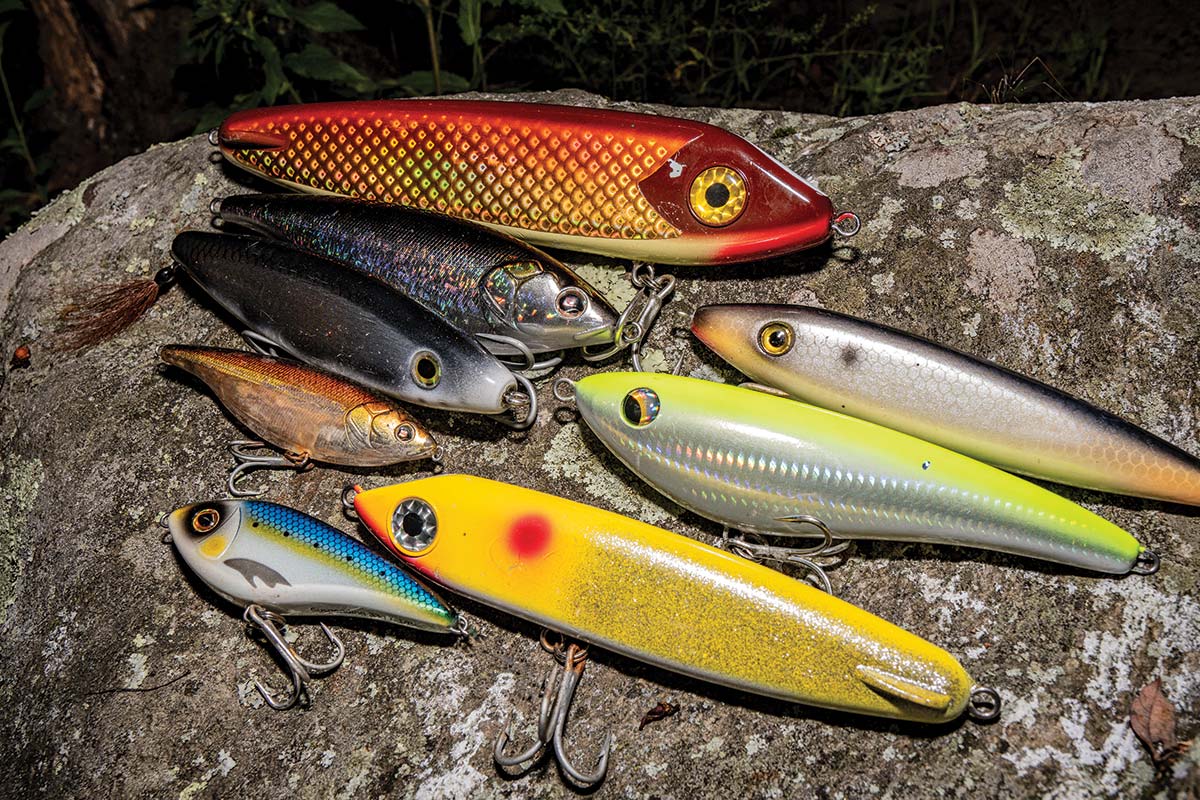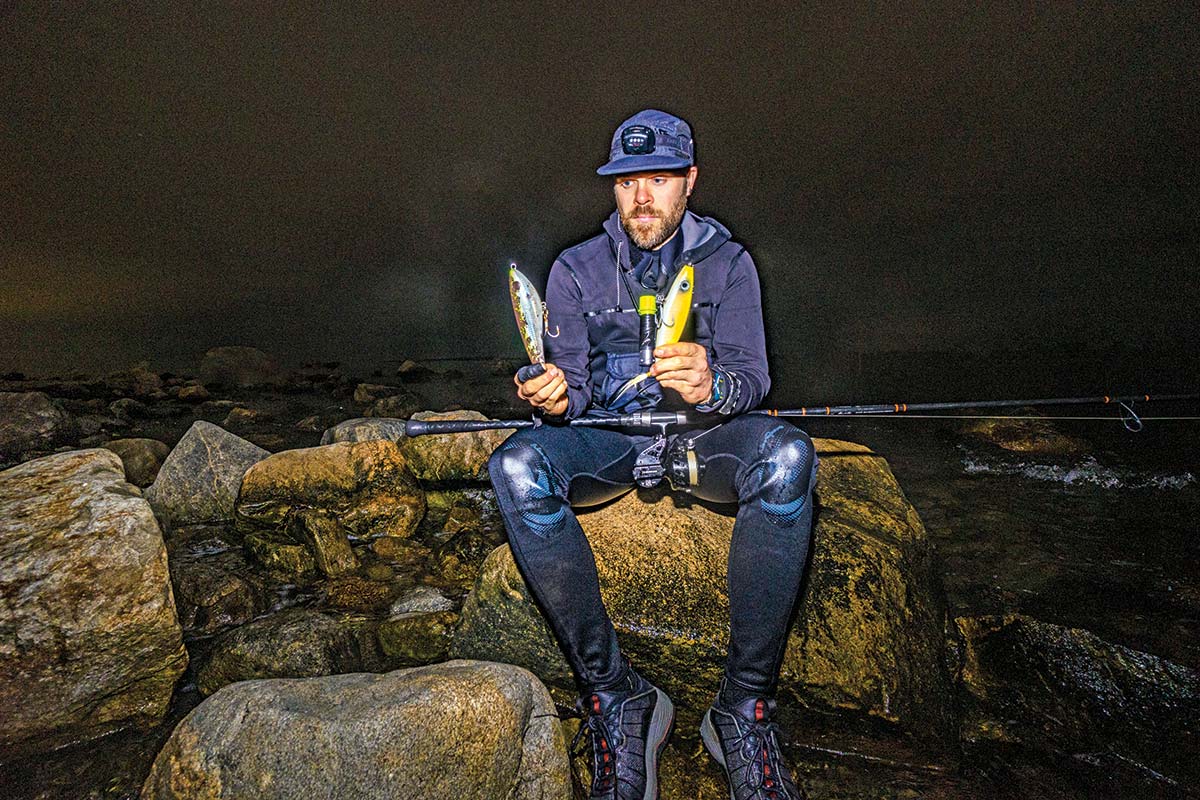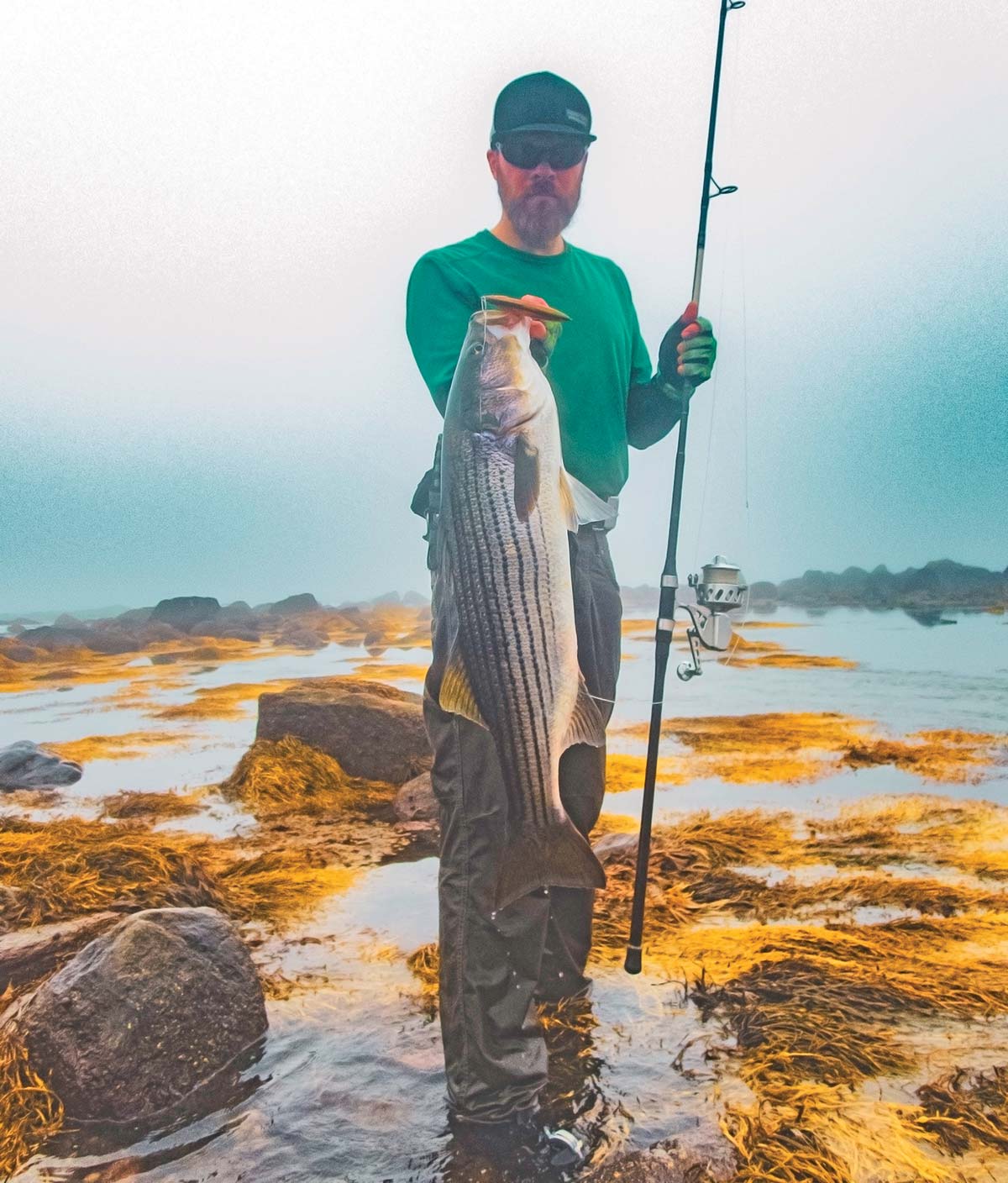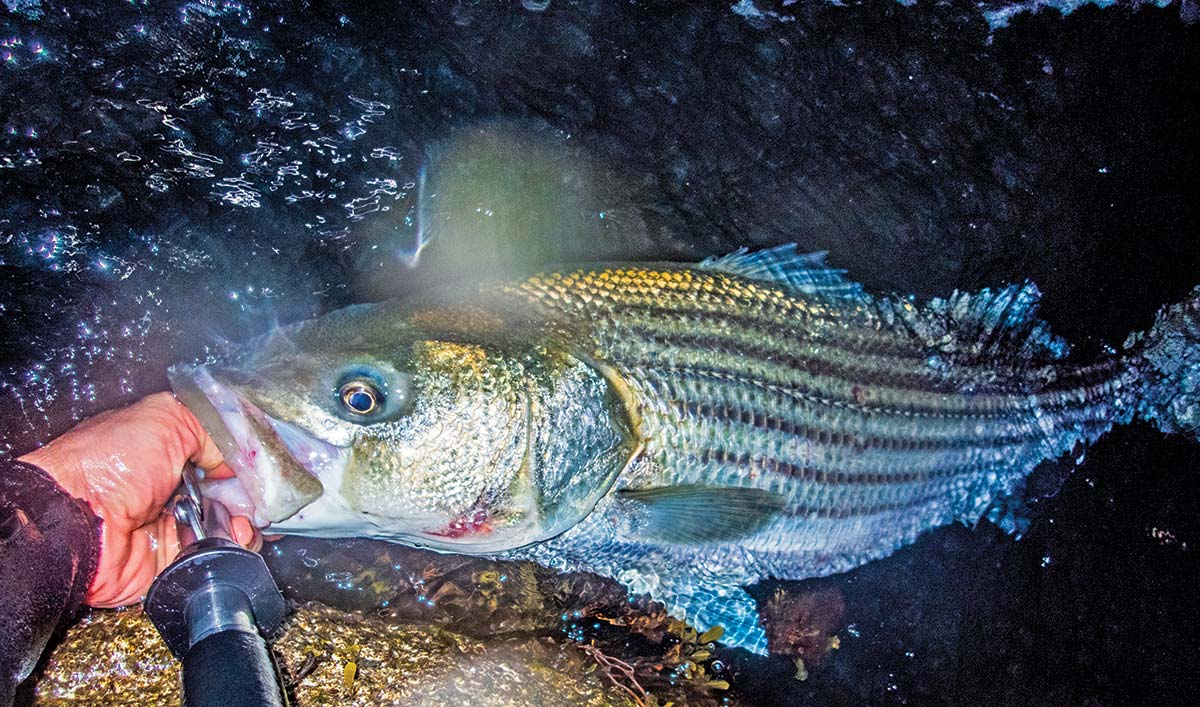
Glide baits project a profile all their own, cast well and hold their own in heavy surf.
Most of the plugs we throw in the surf look a lot alike. They are primarily elongated in shape, being longer than they are deep or tall. While different classes of plugs may do dramatically different things in the water – that is have different presentations and actions – and many reflect a similar profile: tubular, round, and elongated. Sausage, cigar, or torpedo shaped, if you will. You may not have considered it before, but an SP minnow is a very similar shape when compared to a Super Strike Zig-Zag darter, despite being different sizes and having dramatically different actions. The same is true of all plastic swimmers, a lot of sub-surface and surface metal lips, soft plastics, bottle plugs, and even top water poppers. Further, many needles present the same profile in the water, unless you’re using a particularly small or thin needle. There is a good reason for this, as a huge percentage of bait fish (like spearing, mackerel, mullet, herring, etc.) and other forage like lobsters and squid, have this standard shape and profile, as it is a very efficient for moving through the aquatic environment.
However, there are some baits that buck this tubular trend. Likely the most important to the fall run is menhaden (aka bunker or pogies) which have a tall, much rounder profile like a freshwater sunfish. When viewed from directly below, they are thin, but when viewed from the side they are tall and have a very large, disc-like profile in the water. Porgies (scup) have a similar profile as well, as do butterfish, and to some extent blackfish and tautog as well. These baits are all important, and can be found along a huge swath of the Striper Coast and drive a huge percentage of the action the surf fisherman will encounter this fall.
When it comes to your choices to replicate these deep-bodied baits, I believe there is one plug that stands out amongst all others, and that is the glide bait. Also known as stick baits or gliders in some circles, these plugs are generally tall bodied when viewed from the side, while also being thin when viewed from directly below, the front, or behind. In my estimation, they are the ultimate menhaden replicator, and are an absolute essential for all surf fishermen plying the waters from Virginia to Maine. They come in a huge spectrum of sizes, from tiny half-ounce versions, to giant 10-ounce behemoths. However, they’re not just good for replicating menhaden, but are highly versatile and have a number of other substantial benefits compared to other plugs, due to their shape and action. I have at least two in my bag on virtually every trip to the surf – whether I’m fishing a raging nor’easter in boulder fields, a perfectly still night on sand flats, or anything in between. I am infatuated with them, and have found that glide baits out fish other plugs in many of the situations surf fishermen encounter in the fall.
Swimming Glide Baits vs. Jerk Glide Baits
There are generally two different classifications of glide baits available on the market. Both have their place in my bag, and you will have to determine which is right for your spots and style of fishing.
The first is the swimming style glide bait. These plugs are designed to be cast out into the surf and reeled directly back in at a steady pace, with occasional twitches and jerks. Many of the hand-made glide baits available from custom plug builders are in this category. I personally rely on Mikes Custom and Surf Asylum for my “swimming” style gliders, but have several others. When retrieved, these style of plugs glide back and forth in the water with a slight side to side roll. Some are better at responding to jerks and twitches than others, but for the most part, they are designed first and foremost to simply swim on a straight retrieve. Swimming gliders are generally very compact and heavy, and I’ve yet to use one that didn’t cast extremely well. When I bought my first “Z-Glide” from Mike’s Custom Plugs, I asked Mike (the builder) if it would work in moderately big surf, or strong wind. His answer summed up how almost all of these plugs cast. “It’s loaded with lead, so it casts like a rocket!” was his enthusiastic response. He was right, and I’m able to bomb that four-ounce plug out into pretty serious on-shore winds, and it will swim through a moderate surf as well. Their generally heavy weight and moderate to fast sink rates also allows this style of glide bait to be used in deep water, and they are popular in the Cape Cod Canal and with boat fisherman for this reason.

The other style of glide bait is what I call “jerk” glide baits. These plugs typically don’t have as good a swimming action as the other classification of glide baits. When retrieved directly back to the angler on a straight retrieve, they often only have a very wide, subtle, and/or slow S-curve swimming action. That is to say, with many of these plugs, if you retrieve them at moderate or slow speeds, they have very poor or almost no action. The first few times I used one of my favorites, the now discontinued Savage Gear Free Styler, I thought I had wasted my money as it appeared to do almost nothing in the water on a slow retrieve. Only when I started twitching and jerking it did I see the potential of this plug. These plugs dance! They are designed to be used with frequent sweeps, jerks, and twitches of the rod tip along with pauses and accelerations in your retrieve. They are the most “active” plugs I use, with the exception of top water poppers. Examples of these plugs include the ERC Hell Hound, the aforementioned Savage Gear Freestyler, and Bitten Tackles Warlock. I would also place the Sebile Stick Shad in this category as well, though it straddles the line between both styles. With this style of plug, the angler is primarily responsible for creating the action with a very active retrieve. I fish these with a lot of twitches, pauses, and accelerations. On most nights, I look for plugs that have actions very similar to a surface spook lure or suspending jerk bait, and sink slowly or very slowly – something less than one foot per three seconds. This is my preferred style of glide bait, though as I’ve mentioned, both have their time and place.
In full disclosure, I will openly concede I have not tested every glide bait on the market, custom or otherwise, and some glide baits seem to blur the line between the “swimming” style and the “jerk” style better than others. Therefore, before you purchase I would encourage you to think about where and how you’ll most likely use the glide bait, and inquire about the action before you buy it. However, I’ll also point out that I’ve yet to buy a glide bait that I regretted purchasing. Having a variety of actions, sizes, and designs can be an asset, particularly in the fall when weather conditions, bait concentrations, and fish behavior can change so drastically night to night.
Strengths Of The Glide Bait

Both kinds of glide bait have some shared strengths. First they cast relatively well (or very well), as they are thin and heavy for their total size. I believe that gliders are the best casting large-profile plugs that are available. Generally speaking, the only plugs that can exceed them in casting distance are needles, tins, and poppers. Therefore, they work well under a variety of wind and surf conditions, or if you need to reach a distant piece of structure. This is independent of any forage that may be in the area. Sometimes I use gliders simply because they’re the only large-profile plug that can reach the fish, casting upwards of twice the distance of a large-profiled wooden metal-lip. While I generally use them on calmer nights, gliders are phenomenal in storm conditions with strong winds and crashing surf. Bucktails, needlefish, bottle plugs, and gliders are the only plugs I’ll generally be carrying on those nights. The best casting of all the gliders I’ve used is the fast sinking 18cm Sebile – the SS-182-FSK designation. It is capable of reaching distance structure even in very strong winds and will hold the water in anything less than a tsunami. However, it also has the poorest action of any glider I’ve used. Therefore, I consider it a niche plug. Yet, the vast majority of glide baits will cast well into winds up to 25 knots. For reference, the plugs I use regularly reach distances comparable to, or greater than, a 1-¾-ounce Super Strike Needle. Finally, glide bait casting distance particularly shines when you’re trying to deliver profiles at the extreme ends of typical surf baits – small, and very large. The smallest I own is the 1-ounce Sebile at three inches, and the largest is the 10-ounce Hell Hound at ten inches. Both cast remarkably well for their sizes.
As I alluded to at the beginning of the article, glide baits have a distinctly different profile from almost all other plugs, however, it isn’t just that they are good at replicating disc-shaped baits like menhaden. The large surface area of the lure when viewed from the side simulates some of the largest profiles that are castable by surf fishermen. Just the mere size of the lure can be important for drawing both attention and strikes from fish of all sizes, but particularly in drawing the interest of large stripers. Therefore, I believe they are particularly a highly underutilized trophy-fish lure. Further, their ability to be fished subtly and slowly, without much action like a needlefish or darter, can be important when trying to fool really big fish.
Finally, they are highly versatile with regards to how they can be used in the surf, while taking up minimal room in your bag. It’s remarkable all the different ways and places you can use glide baits, and how a single plug can be used to cover the entire water column or spectrum of bait fish behavior. In comparison, I’ll bring up the darter. The darter is the ultimate moderate to heavy current plug, and can be used very effectively in waves as well. However, without some kind of water movement, they are essentially useless. Also, most don’t work well, or at all, if you try to fish them fast, or splashy. I’ve also yet to see someone use a darter on the surface. Yet, a glide bait can do all this, and more. Therefore, I find the glide bait to be a great back up plug or search plug, when you’re not sure what the conditions will be like, where the fish will be holding, or what their behavior will be. I fish my glide baits with a single front treble across the board (no rear hook), so it’s easy to shove them down between the tubes of my plug bag. Therefore, they take up no tube space, but have saved me in situations where I had planned for just one scenario, like sand eels on a calm night, but was forced to fish an entirely different one when suddenly there’s mackerel feasting on the sand eels and the weather man didn’t predict the 15-knot winds I would have to cast into to reach the action.
How To Get Started
I generally work glide baits in three ways. The first technique is my favorite, very simple, and the one I use by far the most. Initially, I like to cast my plug out and let it sink so it’s in the middle of the water column. How long you let it sink is determined by how deep the water is, but for me I’m generally fishing shallow water under 8 feet, so the initial pause is normally only 5 to 10 seconds. Then, I start a slow retrieve, constantly giving the plug random jerks and twitches, interspersed with full stops. The stops are as important as the jerks, as it makes the lure look very realistic. It also will keep the plug in the middle to upper column, as the pause lets it sink while the twitching and sweeping will pull the plug up. It’s the perfect replication of an injured or confused baitfish. This works well in many different situations without large waves or strong current, and is my favorite for boulder fields, rocky flats, and sand beaches.
The second method I use most often is what I call the “slow swing.” This only works if you have some current sweep, and is deadly in outflows and inlets. It’s very similar to what I do with a bucktail in an inlet, or how I utilize the fly rod in many surf scenarios. I will cast my plug up current, let it settle a bit, and then simply stay in contact with it while providing numerous twitches and jerks. My actual retrieve will be very, very slow. My intention is to try and let it stay out in the current and provide erratic action with jerks, sweeps, and pauses – like a bait fish being overcome by the current. I don’t want to reel it in too fast, as the plug moving against or through the current is often an unnatural presentation. Instead, I just keep reeling enough to stay tight to the plug as it swings by in front of me. Once the plug is directly facing into the current, you have two options, which are often dictated by the style you’re using. Swimming-style gliders work great to just slowly crank back to you, tight to shore. This is a classic Cape Cod Canal technique that can be extremely effective if the fish have pushed bait tight to shore. Jerk-style plugs often will rise too quickly to the surface, and therefore I usually just burn the plug in and start the drift over.

Finally, the third way I personally use gliders is almost like a top-water popper. This technique I typically use during the day or when fish are visibly blitzing or I know they’re around in high concentrations. I will cast the plug out, and then work it hard and fast on the surface, making it dance and skip along very similar to a spook. The advantage of a glide bait in these situations are numerous. Compared to a spook, they cast better and will sink on a brief pause, which can be important for hooking up. Compared to a popper, they are more subtle in action and I find I can also work them much faster while retaining a natural looking presentation. I love using this method with the small 1-ounce Sebile (SS-114-SU) when fish are on peanut bunker in the fall, and have found it’s the only way I can hook up at times. The same goes for using my Savage Gear Free Stylers when there are big-fish on adult menhaden. I will even jump the plug completely out of the water, and the fish seem to really respond to this during those times they are aggressively hunting.
While these are the ways I use gliders, there are numerous other ways as well. I have seen them swung in heavy inlet current while scraping the bottom like a bucktail. They can also be worked extremely fast directly with the current, or jigged almost vertically up and down. They can also be effectively used on a pain stakingly slow straight retrieve with no jerking or twitching at all. That is the beauty of the underutilized glide bait. It’s one of the most versatile plugs in the surfcasters bag and I encourage you to test one out yourself this fall.




